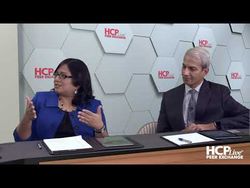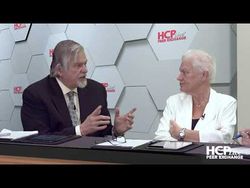Management of Beta Thalassemia - Episode 5
Current Approaches for Beta Thalassemia
Peter L. Salgo, MD: All right. So tell me, because we had this discussion, what year is it? Almost 2020; it’s 2019. What are the goals of therapy for somebody with thalassemia?
Thomas D. Coates, MD: This depends on what country you’re in.
Peter L. Salgo, MD: Well, we’re sitting here in the United State.
Maria Domenica-Cappellini, MD: But at the end of the day, you should say that we want to cure the disease, no? But it’s not yet completely the case. There are some options and maybe you can discuss it.
Peter L. Salgo, MD: We’ll get there, sure.
Maria Domenica-Cappellini, MD: We did make progress on treating that. Now what I want to do before my retirement is to cure them definitively.
Peter L. Salgo, MD: But right now, there’s no cure right now as we’re sitting here at this table.
Thomas D. Coates, MD: Yes.
Peter L. Salgo, MD: As of now, do you have something that can cure the disease?
Thomas D. Coates, MD: Yes.
Maria Domenica-Cappellini, MD: Yup.
Peter L. Salgo, MD: My goodness. What are the current approaches then to treat, to approach ineffective erythropoiesis?
Maria Domenica-Cappellini, MD: When we go back to the pathophysiology, ineffective erythropoiesis is the driver of the phenotype expression of the disease, and ineffective erythropoiesis could be of different grades or severity. What can we do? We can in some way try to correct the unbalance between alpha and beta because this is responsible of ineffective erythropoiesis. Bone marrow transplantation, for example. I mean, we have something to learn about ineffective erythropoiesis. So we need to properly understand it.
Peter L. Salgo, MD: Let me bring up 2 directions of therapy that, when I talk about beta-thalassemia, my colleagues always bring up. They’re pediatricians. They’re not hematologists. EPO [erythropoietin].
Thomas D. Coates, MD: It doesn’t work.
Peter L. Salgo, MD: Well, that’s a pretty good reason.
Thomas D. Coates, MD: That’s not something we would recommend for beta-thalassemia, but I want to step back just a second because I think this is ineffective—erythropoiesis is a very important concept. This is something that really isn’t understood by most people who manage beta-thalassemia.
When we transfuse patients with beta-thalassemia, what we’re trying to do is to suppress their bone marrow. If I bring your hemoglobin level up to 10 or 11 g/dL, which is where we like them to be, that shuts off the bone marrow. And many of the complications of thalassemia major are because of the activity of the bone marrow—boney changes and a lot of problems are caused because the bone marrow is so active. What is probably the most important thing in the current management. We are correcting the anemia to suppress the marrow. And that means keeping their hemoglobin level at 7 or 8 g/dL will not do that. This is a major issue, and people who treat it don’t understand it. We have all these rules in the United States, don’t transfuse patients if their hemoglobin is over 8 g/dL. For thalassemia patients, this is really detrimental.
Peter L. Salgo, MD: Why?
Thomas D. Coates, MD: Because we see patients who come to us who have been undertransfused with bone fractures and osteoporosis and severe complications. So we keep the hemoglobin high to suppress ineffective erythropoiesis. It’s a wonderful adverse effect of this treatment that they feel better when their hemoglobin is high.
Peter L. Salgo, MD: If I understand you correctly, recombinant EPO [erythropoietin] not only does not work, but it’s detrimental.
Thomas D. Coates, MD: No. There is—no, no, no. I’m talking about the topic just before that Nica talked about was ineffective erythropoiesis.
Peter L. Salgo, MD: Right.
Thomas D. Coates, MD: The treatment for beta-thalassemia now, and I’m excluding gene therapy and bone marrow transplantation.
Peter L. Salgo, MD: We’ll get to that.
Thomas D. Coates, MD: We’ll get to that later. The standard treatment is transfusion. The reason we transfuse is to suppress ineffective erythropoiesis, because many of the adverse effects are due to the ineffective erythropoiesis.
Peter L. Salgo, MD: OK.
Farzana Sayani, MD: EPO [erythropoietin] has no role in this. When we transfuse we are shutting off their internal system.
Peter L. Salgo, MD: I bet you’re going there.
Sujit Sheth, MD: Right. And so it actually could be detrimental.
Peter L. Salgo, MD: That was my question.
Sujit Sheth, MD: Because you would expect—you’re driving an ineffective process by giving somebody EPO [erythropoietin]. They have ineffective erythropoiesis, so you’re driving it further. That worsens the bone disease. It worsens the extramedullary hematopoiesis.
Peter L. Salgo, MD: I did get it right.
Sujit Sheth, MD: Yes, and it predisposes you to things like thrombosis, which EPO [erythropoietin] does anyway. And you have the risk with thalassemia already. Absolutely.
Maria Domenica-Cappellini, MD: That was a mistake. Now it’s clear not to use EPO [erythropoietin]. But that was done in the past and was really very risky, because EPO [erythropoietin] is acting in an early stage of erythropoiesis where the ineffective erythropoiesis come out. So you’re giving an EPO [erythropoietin], which potentiates erythropoiesis.
Peter L. Salgo, MD: You’re driving the disease, aren’t you? You’re driving it.
Maria Domenica-Cappellini, MD: Yes, exactly.
Peter L. Salgo, MD: Let’s go to 1 other really old therapy. So old that I know about it: hydroxyurea. That’s been out there for quite a while. Is there a role for it in this disease? What is it? There’s another response.
Thomas D. Coates, MD: No, there are some patients who have some response. I wouldn’t say that it’s a primary thing that we use. There are some patients, especially thalassemia intermediate, meaning patients who have a combination of mutations such that their hemoglobin levels are in the 6.5-to-10-g/dL range. For those patients, some of them, it may be worth trying. Their hemoglobin may come up 1 or 1½ grams. But in general, I don’t think of it as a primary thing.
Maria Domenica-Cappellini, MD: No. In my personal experience, actually, hydroxyurea is not a treatment for thalassemia. It’s a good treatment for sickle cell disease because another story of increasing fetal hemoglobin—although there are some reports, it’s limited to specific population. For example, the Iranian population of thalassemia was treated with hydroxyurea and they apparently respond quite well.
Peter L. Salgo, MD: But there are downsides here, right? Hydroxyurea is not without its adverse effects.
Maria Domenica-Cappellini, MD: Yes, that’s true, but the dose we are going to use in case thalassemia has too many adverse effects, but the problem is doing something—as Tom said, I use hydroxyurea occasionally in those patients with beta-thalassemia, with no transfusion-dependent beta-thalassemia, who have actually have extramedullary hematopoiesis, which may be responsible for severe manifestation. Sometimes they come in and they cannot walk anymore because they had the pressure along the spine. And the hydroxyurea works in such a situation.
Peter L. Salgo, MD: Hydroxyurea, by the way, does have effect on reproductive health, isn’t that right?
Maria Domenica-Cappellini, MD: Not really. There is experience based on the use of hydroxyurea in other hematologic conditions, such as polycythemia and so on. They really don’t show specific effect on the cure. But of course if I have a patient on hydroxyurea and she wants to become pregnant, I stop hydroxyurea in any case.
Transcript edited for clarity.



